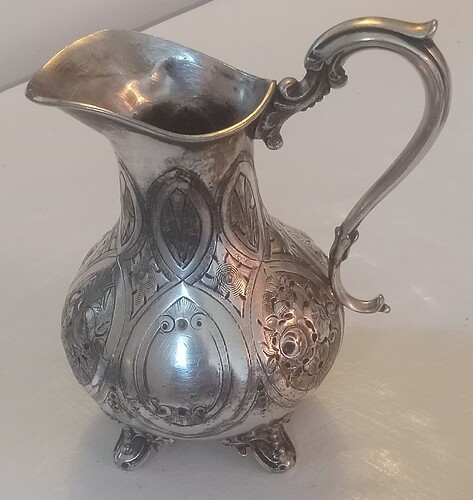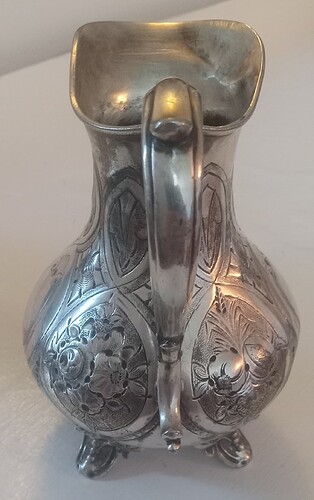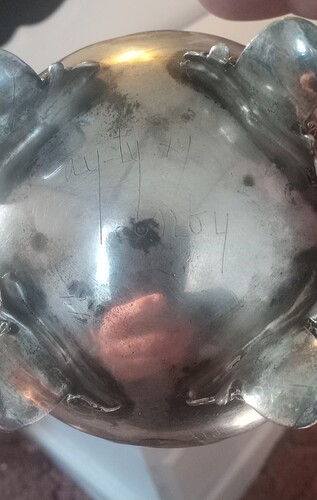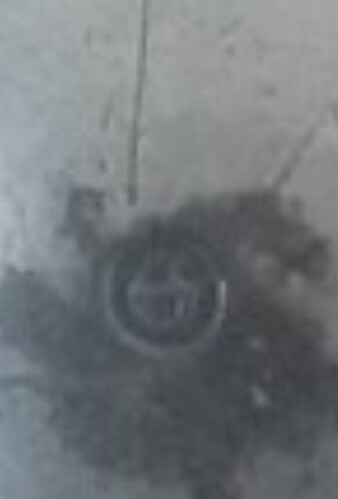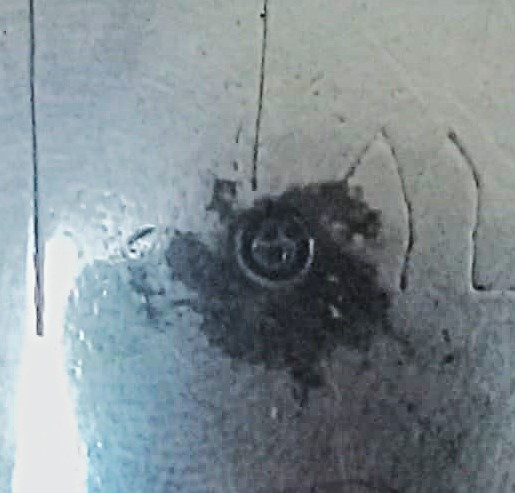Not a silver buyer or seller but received a sole piece, being a creamer, and I’d like to get some documentation attached to it so it moves through its life appropriately going forward. No hallmarks noted, but there are some incised letters on the bottom. Some suspicion from my uninformed research that maybe a mid 1800 sort of timeline and perhaps coin silver although not marked as such. 100% these are just guesses from someone with no background or experience. Any assistance would be greatly appreciated.
The lettering on the bottom is typical of the hand-scrawled marks put on pieces by their owners at some stage of the game. Makers use punches, not hand-inscribed lettering.
If there are no other marks on the piece, it would be impossible to guess what it is. But silversmiths are generally not shy about clearly indicating that they’ve used precious metal when fabricating a piece like this. The safest bet is that if it doesn’t say that it’s sterling, or at least .800 silver, it isn’t silver. But you could have it tested.
Doing a quick image search turns up many, many similar pitchers. Most are identified as being mid-Victorian, in the 1860-1875 range. Many are silverplate, but some are sterling or “coin silver” (which actually covers the range from .800 to .900 purity). But the ones that are sterling or coin silver are always marked as such - no guessing required. ![]()
Hi Jeff:
Your image search may have turned up tea sets produced by Atkins Bros in their Truro Works on Matilda St, Sheffield about 1875? The pattern is one of theirs. It may not be marked because it is an ancillary item and came together with teapot and hot water jug. Or equally possible it may be a knockoff.
Here’s a very similar tea set. However you will notice, unlike this item, it is clearly marked: HA HA EA and EPNS. on the cream jug as well.
CRWW
I think we can at least be fairly certain that this is not sterling. That little mark might be a clue to the maker, but it’s not a true hallmark.
ETA: Either that, or it’s the metalworking version of a pontil mark. I could be persuaded either way! ![]()
Thank you. I generally agree and likely will test and be OK with whatever the results are. Yes, no other markings found except for what might be numbers below and to the left of the bottom center hole. I’ll give it a better look over in two days upon returning home.
Peeked back at some very nice pieces from the 1700 and very early 1800’s, and similar holes were present on several. Part of the manufacturing process of the day perhaps.
You are looking at chuck marks from lathe-spinning silver which would be one of the first step in the manufacture of this cream jug. You will notice them on almost anything which is perfectly round and not hammered out.
Eighteenth century beer mugs and tankard, coffee pots all show them too.
By the time this item was manufactured, probably around 1875, lathes were steel and rotating at about 800 rpm. The chuck pattern is designed to lock and hold the plate and you can see the chuck-face extrusions on this mark.
It’s an old process. Egyptian silver was spun and everybody has done it since on round vessels including plates and bowls as well as cups and beakers.
Now if the item is not round, if it is oblong the system does not work and on these you can see the hard solder joins top to bottom usually under the handle and the soldered on bottom. I have got spun mugs and plates and those made of sheet metal either beaten or rolled, depending upon the date. if you want to see examples.
After the item and its base are spun, the next step is creation of beaks or spouts and the attachment of handles either caste or assembled from sheet.
Despite the mechanization of the process it remains essentially hand work and skilled handwork.
After that come the repouse work pushing out the silver from the inside either by hand or by mould and then finally the brightwork cutting the exterior designs you can see on your creamer. Imperfections or lack of uniformity will show hand work.
If you get a chance go visit a metal shop and you will see much of this process in action. Doesn’t need to be silver, copper works. You might even get a chance to try your hand.
Sometimes you will see modern chuck impressions on the bottom of mugs that have been made, by the marks of them, centuries before the high speed lathe was invented. Don’t worry, this simply means someone had re-spun an item to smooth out bumps and dents accumulated down though the years and restoring the item to perfectly round.
Christopher
Guildhall Antiques
Toronto
Canada
